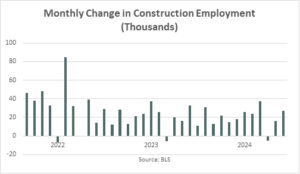by Arsene Aka, Senior Economist at Dodge Construction Network
Despite easing, the U.S. labor market continues to defy expectations. Data published last week by the Bureau of Labor Statistics (BLS) shows that the U.S. economy added 206,000 jobs in June, well above the consensus expectations for a 190,000 gain. The job figure is a slowdown from both May’s downwardly revised gain of 218,000 and the average monthly gain of 220,000 recorded over the prior 12 months. Meanwhile, the unemployment rate edged higher to 4.1%, reflecting a higher labor force participation. In addition, growth in the average hourly earnings for all U.S. employees on private nonfarm payrolls continued its downward trend, easing to 3.9% year-over-year last month.
Employment in the construction sector increased by 27,000 in June, following a 16,000 increase in the previous month. This is higher than the average monthly gain of 20,000 posted over the prior 12 months. Growth was broad-based across all construction categories, with the largest gain occurring in nonresidential specialty trade contractors (9,200), followed by heavy and civil engineering (6,300), and nonresidential building (5,700). In addition, residential building and residential specialty trade contractors saw a combined 5,500 increase in employment. Wage growth in the construction industry stood at a strong 4.9% year-over-year in June, owing to labor shortages. The sector’s jobless rate has trended down since March; it fell to 3.3% in June, a significant decline from February’s 7% rate.
Job growth in the construction sector stood at 3% in the first half of the year, easing from 3.4% during the same period a year earlier. Dodge Construction Network expects the Federal Reserve will deliver a maximum of two interest rate cuts this year and then cut rates by 25 basis points every quarter until the funds rate returns to its equilibrium of about 3%. As a result, Dodge expects robust construction

